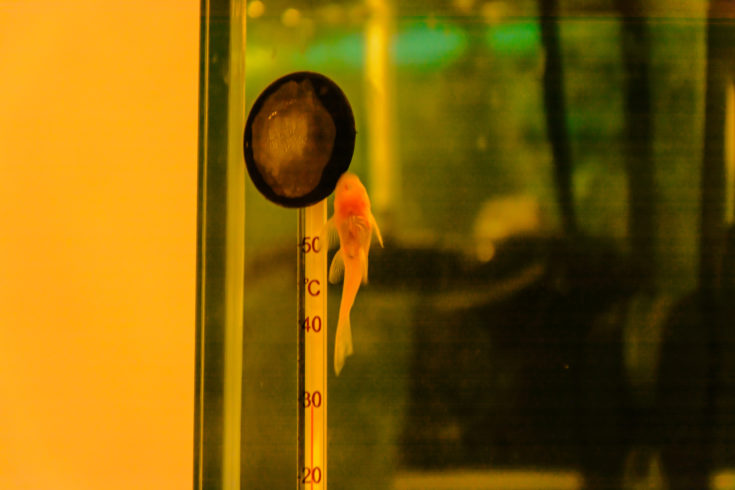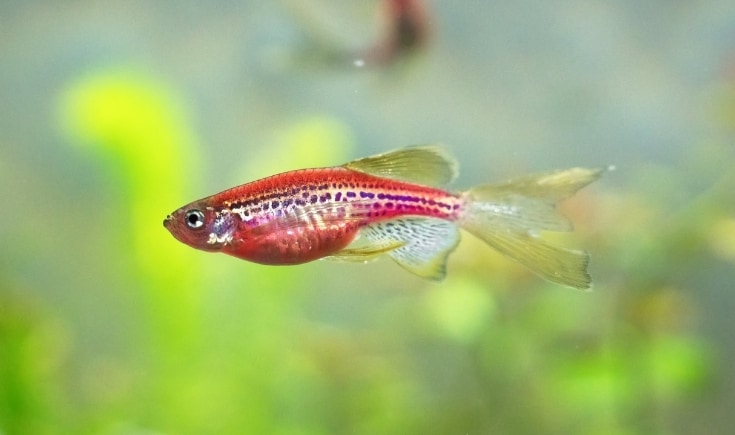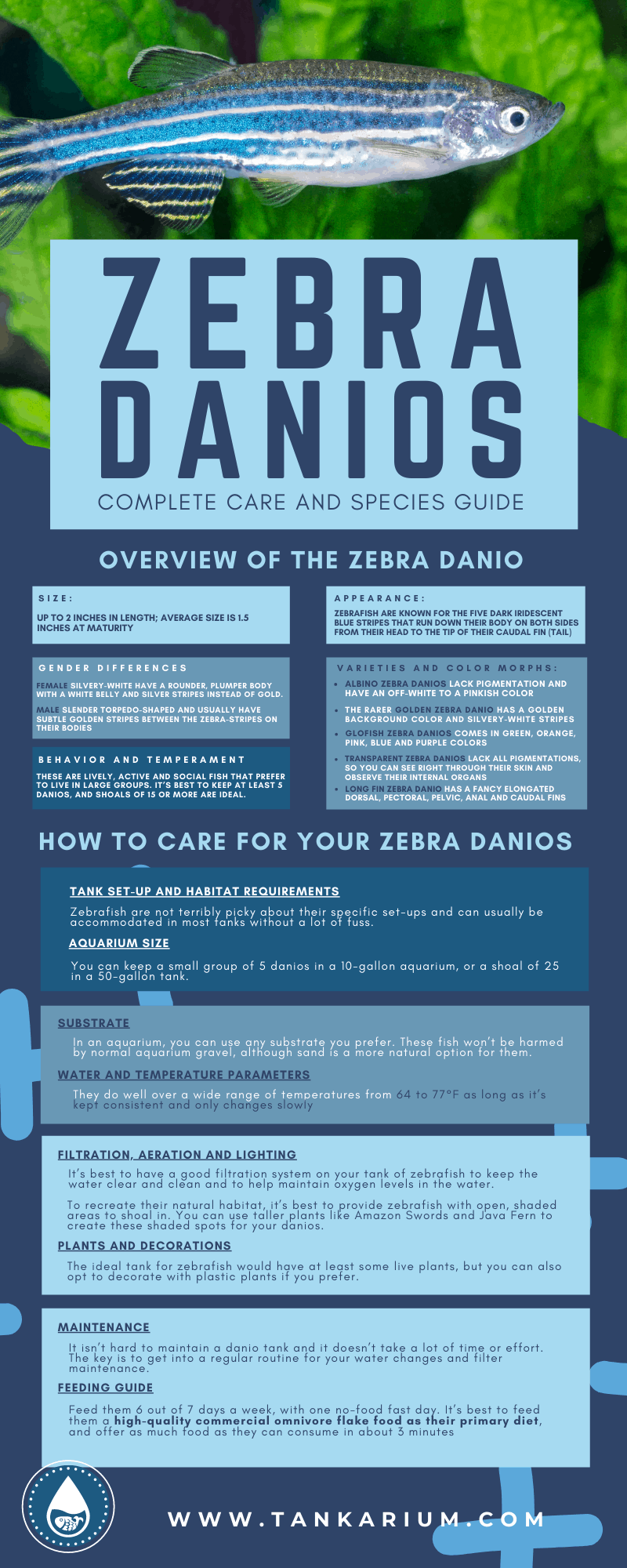If you’ve ever wondered why Danios are such a popular choice for freshwater aquariums, then wonder no longer. These zebra-striped fish are both beautiful and hardy, and are one of the easiest aquarium species to care for and breed. Ideal for novice and experienced aquarists alike, let’s explore the playful Zebra Danio!
Overview of the Zebra Danio
The striped Zebra Danio (Danio rerio) is a mainstay in the aquarium trade and has been so for many decades. I’d hazard a guess that there are few aquarium stores in the United States that don’t have at least one type of zebrafish for sale. Let’s talk about why these social fish are such a popular option for freshwater tanks.

| Scientific Name | Danio rerio |
| Common Name | Zebra Danio, Striped Danio, Zebrafish |
| Care Level | Easy |
| Size Range | Up to 2 inches in length; average size is 1.5 inches at maturity |
| Diet | Omnivore; In the wild, they eat small insects and eggs, algae, crustaceans and worms |
| Activity | Active, curious, schoals in larger groups (15+) |
| Temperament | Playful and very social |
| Min Tank Size | 10 gallons |
| Temperature Range | 64 to 77°F |
Natural History of the Danio
Zebra danios are small freshwater fish native to South Asia. Found originally in various parts of India, Pakistan, Bangladesh, Nepal and Bhutan, the striped danio has also been released into the wild (both deliberately and by accident) in Columbia, Malaysia and parts of the United States. Danios are:

- Members of the large Cyprinidae or minnow family.
- Omnivorous and feed primarily on zooplankton, phytoplankton (including algae), small insects and larvae.
- They will also consume small crustaceans and worms if their preferred foods are unavailable.
- Tolerant of a wide range of habitats and water conditions.
- Wild populations exist in slow and fast-moving streams, rivers, lakes and even nearly stagnant irrigation ditches and rice paddies.
- They usually are found in shallow water shaded by aquatic or overhanging vegetation with a sandy or silty pebbled-filled substrate.
- “Danio” derives from the Bangla name Dhani, which means “of the rice fields”.
Zebrafish, as they are also called, are just one of the 23 species of danio currently recognized. Other popular aquarium varieties include the Pearl Danio (Danio albolineatus), Celestial Zebra Danio (Danio margaritatus), and Emerald Dwarf Rasbora (Danio erythromicron).
Importance to Science and Research

The zebrafish was first described in India in 1822 by the Scottish physician and explorer Francis Hamilton. Initially dismissed as a fish with no economic worth, they’ve since become a model species for scientists studying everything from genetics of neural development to cancer, and have even been sent into space!
This extensive research has led to zebrafish being one of the best-understood species on the planet:
- Their DNA was fully sequenced in 2001 and continues to be studied in more than 600 labs around the world.
- Their easy breeding habits and large, transparent eggs make them ideal for laboratory experiments.
- They share about 70% of their genetic material with humans, so they’re ideal for studying diseases like diabetes and muscular dystrophy, and for use in developing new drugs and treatments.
Danio Size and Appearance

How big do zebra danios get? They’re usually sold as juveniles from about 0.5 to 1 inch in length, and a mature zebra danio’s size usually tops out at around 1.5 to 2-inches. Pond fish may grow larger than danios kept in aquariums.
Zebrafish are known for the five dark iridescent blue stripes that run down their body on both sides from their head to the tip of their caudal fin (tail). Their bodies are shaped like a spindle (fusiform) and they have an upward-facing mouth. Their natural background color is usually a subtle silver to gold striping.
Sexual Dimorphism aka Gender Differences
The slender zebra danio males are torpedo-shaped and usually have subtle golden stripes between the zebra-stripes on their bodies. The silvery-white females have a rounder, plumper body with a white belly and silver stripes instead of gold. They also have a prominent genital papilla, or folded tube, right in front of their anal fin.
Varieties and Color Morphs
While the wild type zebrafish is a popular choice, there are many other interesting varieties available in the aquarium trade and to research labs. Naturally occurring mutations, artificial selection by breeders and the increasing use of genetic modification has led to several unique morphs, including:

- The naturally occurring Albino Zebra Danios lack pigmentation and have an off-white to a pinkish color.
- The rarer Golden Zebra Danio has a golden background color and silvery-white stripes.
- There are also genetically modified zebrafish that glow under a fluorescent light. These GloFish Zebra Danios come in green, orange, pink, blue and purple colors.
- Transparent Zebra Danios were created by scientists for research and are not yet available commercially (but may soon be). They lack all pigmentations, so you can see right through their skin and observe their internal organs.
- There is also a Long Fin Zebra Danio, which has fancy elongated dorsal, pectoral, pelvic, anal and caudal fins.
Danio Lifespan
In the wild, zebrafish are considered an annual species and generally only live for about a year. But when well cared for, you can expect your aquarium fish to live for about 2 to 5.5 years.
Behavior and Temperament
What is the typical behavior of zebra danios in an aquarium? These are lively, active and social fish that prefer to live in large groups. It’s best to keep at least 5 danios, and shoals of 15 or more are ideal. When kept on their own, these fish are shy and spend most of their time depressed and hiding.
Zebrafish develop a social hierarchy through play and shoaling (swimming in loose groups). They often nip at and chase each other harmlessly. Zebras use all parts of your aquarium, but prefer to hang out at the top and in the middle sections. They prefer to swim in the shaded open areas of your tank.
In terms of temperament, these fish usually get along well with other peaceful community species of a similar size and shape, but they often harass slow-moving fish with long fins. While they safely form hierarchies through their non-aggressive play, they could stress or injure slower fish as they nip at their fins.
How to Care for Your Zebra Danios
Zebrafish are one of the easiest species to care for in an aquarium and make a good option for outdoor ponds as well. This makes them an ideal choice for new fish keepers and either single species or peaceful community tanks.
Tank Set-up and Habitat Requirements

Zebrafish are not terribly picky about their specific set-ups and can usually be accommodated in most tanks without a lot of fuss.
Aquarium Size
What’s the best tank size for zebra danios? It depends on how many fish you’ll want to keep in your shoal. You can keep a small group of 5 danios in a 10-gallon aquarium, or a shoal of 25 in a 50-gallon tank. As long as you provide them with a good 2-gallons per fish and avoid groups smaller than 5, your fish should be fine.
Substrate
In the wild, zebrafish live in silty or sandy-bottomed bodies of water. Truthfully, in an aquarium, you can use any substrate you prefer. These fish won’t be harmed by normal aquarium gravel, although sand is a more natural option for them. They really stand out beautifully in a tank with a dark sand and pebble mix.
Water and Temperature Parameters
What kind of temperatures and water conditions do zebra danios prefer?

- They do well over a wide range of temperatures from 64 to 77°F as long as it’s kept consistent and only changes slowly.
- Aquatic heaters are useful, but you may not need one for your striped danios if your tank doesn’t fluctuate much and stays consistently within a couple of degrees.
- They are not particularly sensitive to water hardness as long as it’s between 5 and 12 dGH.
- Zebrafish prefer a pH between 6.0 and 8.0.
Filtration, Aeration and Lighting
It’s best to have a good filtration system on your tank of zebrafish to keep the water clear and clean and to help maintain oxygen levels in the water. A simple internal filter may suffice for a nano tank, while a HOB or canister system would be better for larger set-ups.
While wild zebrafish can often be found in stagnant waters, it’s best to provide your fish with a gentle current and plenty of circulation to prevent other problems with your tank (like algae outbreaks). I’ve seen my zebra’s playing in my filter outflows, and they enjoy swimming through bubbles too, so consider adding an air stone.

To recreate their natural habitat, it’s best to provide zebrafish with open, shaded areas to shoal in. You can use taller plants like Amazon Swords and Java Fern to create these shaded spots for your danios. They may avoid playing in any brightly lit areas away from decor and plants.
Plants and Decorations
The ideal tank for zebrafish would have at least some live plants, but you can also opt to decorate with plastic plants if you prefer. They enjoy exploring decorations as well, especially chunks of bogwood.
But they aren’t really sensitive to their decorations, so choose the decor that works best for your tank and community. Zebrafish don’t like a bare tank, and they tend to be more aggressive when they don’t have a lot of plants and decorations to break up their habitat.
Maintenance
It isn’t hard to maintain a danio tank and it doesn’t take a lot of time or effort. The key is to get into a regular routine for your water changes and filter maintenance. Poor hygiene may cause your fish stress and shorten their lifespans, and may increase the chances of algae outbreaks and diseases in your tank.
Feeding Guide
What do zebrafish eat and how often should you feed them? As omnivores, they enjoy both plant and animal foods. I usually feed my danios 6 out of 7 days a week, with one no-food fast day. I offer them their primary diet five times a week, and treat foods in place of their meal once a week.
- It’s best to feed them a high-quality commercial omnivore flake food as their primary diet, and offer as much food as they can consume in about 3 minutes.
- You can also offer them occasional flakes of algae as well.
- For treats, you can offer them fresh/frozen/dried brine shrimp, bloodworms or mosquito larvae.
- They also enjoy treats of blanched vegetables like spinach, cucumber, and zucchini.
Feeding Breeding Colonies and Fry
For breeding zebrafish, it’s best to feed them on brine shrimp, Daphnia eggs and bloodworms for a few weeks prior to spawning. Newly hatched zebrafish fry do best on a mixture of powdered omnivore foods and fresh brine shrimp fry until they are large enough for regular foods.
Tank Mates

What are the best tank mates for zebra danios? You have a lot of options, including small tetras like the Neon, Cardinal, Rummy Nose and Emerald. They make good choices for communities with gourami, Cherry and Gold Barbs. You can also house them with other types of danios.
Zebrafish also work for tanks with Nerite, Zebra or Assassin Snails. You can keep them with small freshwater invertebrates like Ghost or Cherry Shrimp, or with aquatic amphibians like the African Dwarf Frog. Other possibilities include Cory Cats, loaches and Upside Down Catfish.
Species to Avoid
Avoid keeping zebras with long-finned or slow-moving fish like Sailfin Mollies, Fancy Guppies, Fancy Goldfish or Bettas, or any large or aggressive species like Tiger Barbs or Red-Tailed Sharks. If your zebras are acting aggressively with the community, try breaking up the tank with more decor and live plants.
Overview of Danio Breeding
It’s incredibly easy to breed zebrafish, and they are a great choice for first-time fish breeders. You’ll need several small breeding tanks with heaters, sponge filters and air stones. Separate your fish into tanks by gender for a few weeks, and raise their water temperature from 71 to 80°F to signal it’s time to spawn.
After two weeks of a high-protein diet, your female fish should start looking plump and rounded. It’s time to transfer them to the spawning tank. Add 2 males for every female. You should see transparent eggs at the bottom of your tank within 24 hours. Infertile eggs are not transparent and look white instead.
Once the adults have spawned, return them back to their home tanks or they will eat the hatching fry. Your baby fish should hatch within 3 days and will be very small and transparent at first.
Health Concerns
Striped danios are usually healthy and hardy fish, but they are susceptible to common aquatic diseases like ich, so your tank’s hygiene will play an important role in the overall health of your shoal. Stressed fish are more likely to get sick, after all, since stress depresses their immune system.
Zebrafish are also highly susceptible to a chronic bacterial infection called Mycobacteriosis, which is especially common in laboratory colonies:

- This disease causes fish to be lethargic, anorexic and develop inflammation and ulceration on their skin and fins.
- Sick fish may develop dropsy (edema or body swelling), nodules on their internal organs and may even have deformed muscular and skeletal development.
- This is a zoonotic disease, and you can potentially become infected through any open wounds on your skin.
There is no treatment for Mycobacteriosis, as it’s usually related to poor animal husbandry practices. Antimicrobial medications don’t seem to have much effect, and an outbreak usually results in the loss of the colony. It’s best to avoid it by keeping your water quality high and quarantining new fish before adding them to your tank.
What Supplies Do You Need for a Zebrafish Tank?
Here’s a quick shopping list of the supplies you’ll need for an ideal danio tank appropriate for a shoal of 10:

- 20-gallon aquarium with a hood/cover and lights.
- Internal, HOB or canister filter.
- Sandy substrate with a mix of smooth pebbles and rocks.
- Air pump and air stone or bubbling device.
- Live or plastic plants and decor; bogwood and sticks/branches are especially appropriate.
- A heater, if your home’s temperature is variable or swings more than a few degrees every day.
- A bottle of water conditioner to remove any chlorine or chloramine from your tap water.
To feed and care for your danios, you’ll need:
- A high-quality commercial omnivore flake diet.
- Treats such as brine shrimp, bloodworms, Daphnia eggs and/or mosquito larvae.
- Algae flakes and fresh blanched veggies for occasional treats.
| Common Name (species) | Zebra Danio (Danio rerio) |
| Family | Cyprinidae |
| Origin | South Asia in India, Pakistan, Bangladesh, Nepal and Bhutan |
| Diet and Feeding | Omnivore; Primary diet of fish flakes, supplemented with fresh/frozen brine shrimp, blood worms, algae flakes and blanched vegetables |
| Care Level | Easy |
| Activity | Very active, curious and a shoaling species in large groups (15+) |
| Temperament | Playful and very social; often chase and nip at each other harmlessly |
| Tank Level | Upper and mid-levels mostly, but does explore the bottom as well |
| Minimum Tank Size | 10 gallons (2 gallons per fish) |
| Temperature Range | 64 to 77°F |
| Water Hardness | 5 to 12 dGH |
| pH Range | 6.0 to 8.0 |
| Filtration/Flow Rate | Prefers well-filtered water with a slight current |
| Breeding | Egglayer; Ideal species for first-time breeders and very easy to induce spawning in a breeding tank |
| Compatibility | Does well with many other peaceful, similar-sized fish that prefer the same conditions. Avoid keeping with large or aggressive fish that might attack them, or with slow swimmers with long fins that may get nipped |
| OK for Planted Tanks? | Ideal for planted tanks |
Conclusion
Zebrafish may be common, but they are anything but boring! I hope you’ve enjoyed this guide, and we’d love to hear any questions or comments you may have about these beautiful striped danios. You can drop a comment below, or join us and our community of aquarium aficionados on our social media pages!

